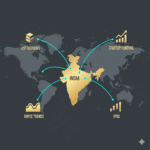India’s GST Bachat Utsav: What GST 2.0 Means for Consumers and Businesses
Key GST-Related Updates (India)
From September 22, 2025, India officially rolled out GST 2.0, a major overhaul reducing slabs from four to just two:
5% for essentials
18% for standard goods and services
40% for ultra-luxury and sin goods
Highlights:
Household goods and staple foods (like roti, parantha, paneer, khakhra), along with medicines and insurance premiums, now attract nil or lower GST rates, making them more affordable.
Premium clothing above ₹2,500 now falls under the 18% slab (up from 12%).
PM Modi called this reform the “GST Bachat Utsav”, highlighting how it will boost household consumption and formal sector savings, especially ahead of the festive season.
The GST Council also hinted at further reforms in registration, returns, and refund processes.
Business & Finance Highlights
BMW Ventures Limited IPO: Opening September 24, aimed at strengthening financial flexibility and reducing company debt.
AI-driven efficiency: Sectors like HR, marketing, and finance are adopting AI-integrated strategies, reporting 20–30% higher operational efficiency and up to 75% improved ROI.
Anti-money laundering reforms: FIUs globally are adopting AI, with 65% penetration, though disparities remain in policy rigor and analytical efficiency.
China’s accounting reforms: China has mandated accrual-based reporting as of September 24, 2025, to better manage local debt risks.
Conclusion
With GST 2.0 simplifying tax slabs, IPO opportunities opening, and AI reshaping business functions, India’s financial landscape continues to adapt dynamically.
✨ This Navratri, celebrate new beginnings with 25% off Pvt Ltd & Trademark registration fees. Contact us today to get started!
FAQ'S
Q1. What is GST 2.0 and when did it come into effect?
GST 2.0 is India’s new tax structure with two slabs (5% and 18%) plus a 40% rate for luxury goods, effective September 22, 2025.
Q2. Which essentials are cheaper under GST 2.0?
Staple foods (like roti, paneer, khakhra), medicines, daily essentials, and insurance premiums now attract nil or reduced GST rates.
Q3. Are there any goods that got costlier?
Yes, premium categories such as clothing above ₹2,500 are now taxed at 18%, up from 12%.
Q4. Why is the government calling this the “GST Bachat Utsav”?
Because it helps households save more, especially during the festive season, while encouraging formal sector spending.
Q5. What’s the latest in global financial reforms?
AI adoption is improving efficiency in multiple sectors, anti-money laundering rules are being enhanced, and China has introduced accrual-based accounting for better debt management.





